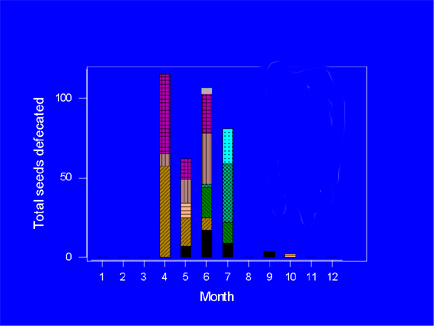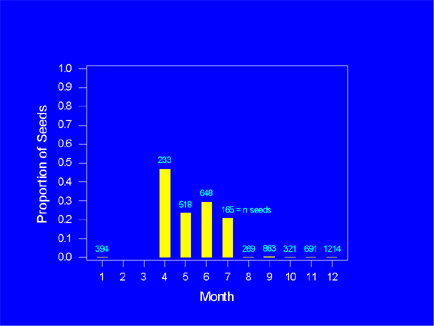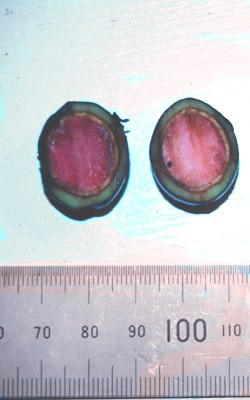Colonization Results
|
What is Colonizable Habitat? In Cooloola National Park, many areas of rainforest appeared to have been destroyed in a wildfire in 1951. While some areas regenerated into rainforest, others did not because of continual burning by loggers and, more recently, National Parks staff. In the 1980's the Parks staff increased the interval between controlled burns and some areas now appear to be at the beginnings of the process of converting to rainforest. This is where I carried out my work on colonization of vacant habitat.
|
 A
controlled burn moving through an area of open woodland.
This area had some rainforest seedlings present but was further
from the rainforest edge than some regenerating areas. This
fire dampened off and died as it reached areas with a more
advanced community of rainforest seedlings and saplings. A
controlled burn moving through an area of open woodland.
This area had some rainforest seedlings present but was further
from the rainforest edge than some regenerating areas. This
fire dampened off and died as it reached areas with a more
advanced community of rainforest seedlings and saplings. |
|
Seasonality of Dispersal Radio-tracking of Wompoo and Rose-crowned Fruit-doves and Green Catbirds showed conclusively that these individuals were moving into regenerating habitat some of the time. Surprisingly however, this movement was very seasonal with movements from rainforest into vacant/regenerating habitat restricted to April-July.
|
|
Diversity of Dispersal These frugivorous birds were dispersing a diversity of rainforest species to regenerating habitat, but nowhere near the diversity of rainforest species present. Clearly birds were facilitating colonization for a limited subset of rainforest species particularly those that fruited between April and July.
|
 Graph showing the number of seeds dispersed per month by species. Only 9 species of rainforest seed were dispersed to regenerating habitat despite the fact that I observed these bird species feeding on over 30 species of rainforest fruit. |
 Graph showing the proportion of defecated rainforest seeds that
were deposited in regenerating areas rather than rainforest.
Small numbers in blue indicate the sample size in number of seeds
defecated per month. While there was no data from
February-March, all other evidence suggests that birds were
facilitating colonization only between April and July.
Graph showing the proportion of defecated rainforest seeds that
were deposited in regenerating areas rather than rainforest.
Small numbers in blue indicate the sample size in number of seeds
defecated per month. While there was no data from
February-March, all other evidence suggests that birds were
facilitating colonization only between April and July.
 Graph showing the numbers of seedlings surveyed in
regenerating forest and the month in which they were most likely
deposited. I calculated this by looking at the fruiting phenology
of each plant species. For example, if I knew that one species
fruited every year only in July, then I could assume that seedlings of
that species must have germinated from seeds that were dispersed in
July.
Graph showing the numbers of seedlings surveyed in
regenerating forest and the month in which they were most likely
deposited. I calculated this by looking at the fruiting phenology
of each plant species. For example, if I knew that one species
fruited every year only in July, then I could assume that seedlings of
that species must have germinated from seeds that were dispersed in
July.